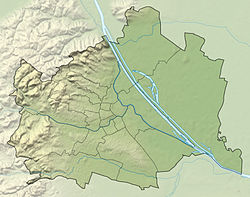| Vienna Islamic Centre | |
|---|---|
Islamisches Zentrum Wien | |
 The mosque in 2015 | |
| Religion | |
| Affiliation | Islam |
| Ecclesiastical or organisational status | Mosque |
| Leadership | Dr. Hashim Al-Mahrougi |
| Status | Active |
| Location | |
| Location | Floridsdorf, Vienna |
| Country | Austria |
Location of the mosque in Vienna | |
 | |
| Geographic coordinates | 48°14′42″N16°23′51″E / 48.24500°N 16.39750°E |
| Architecture | |
| Founder | Faisal bin Abdulaziz al Saud |
| General contractor | Richard Lugner |
| Groundbreaking | 1 July 1977 |
| Completed | 1979 |
| Specifications | |
| Dome(s) | 1 |
| Dome height (outer) | 16 metres (52 ft) |
| Dome dia. (outer) | 20 m (66 ft) |
| Minaret(s) | 1 |
| Minaret height | 32 m (105 ft) |
| Site area | 8,300 m2 (89,000 sq ft) |
| Website | |
| izwien | |
The Vienna Islamic Centre (German : Islamisches Zentrum Wien) is the largest mosque in Austria, located in Vienna's 21st district Floridsdorf.




